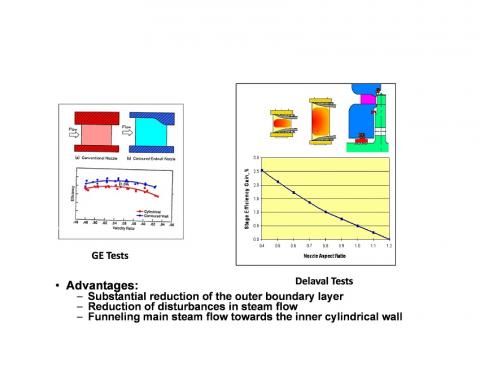Contoured end wall in HP nozzle rings and diaphragms

This innovative design feature is applicable to several first stages operating with high steam conditions. High steam pressure and temperature results in high density steam. Small volumetric steam flow requires partial arc steam admission, short vanes and rotating blades. At the same time, high pressure drops across these stages require special re-enforced vane airfoils and a large axial width of the nozzle ring and diaphragm in order to withstand heavy loads.
Due to low aspect ratio (i.e. relationship between small vane height and large axial width) in these stages, their steam path forms long and narrow passages for steam flow, resulting in increased profile and secondary losses. The end wall boundary layer in these stages plays a much more negative role compared with taller blading because it:
- Significantly decreases the actual steam passing area;
- Actively interacts with the main steam flow forming an additional radial flow, which causes disturbances and energy losses.
Special profiling of the outer wall (i.e. the inner surface of the outer spacing strip) allows for significant reduction in the profile and secondary losses. This is achieved by the following:
- Substantial reduction of the outer boundary layer, especially near the exit edge;
- Reduction of eddies and other disturbances in the main steam flow;
- Funneling the main steam flow towards the inner cylindrical wall (i.e. the outer surface of the inner spacing strip).
The idea of special profiling to the outer wall in nozzle rings and diaphragms with a low aspect ratio was published back in the 1950's. However, it could not be materialized due to manufacturing limitations. It was revitalized in the 1980's, and since then, numerous studies regarding this issue are being conducted in different countries. Testing confirmed that contouring of the outer end wall in the subject stages results in an increase in stage efficiency (Figure 1) and reliability. Currently, the industry allows for the manufacturing of nozzle rings and diaphragms with a contoured end wall in new and revamped steam turbines.
Optimal tangential lean of vanes